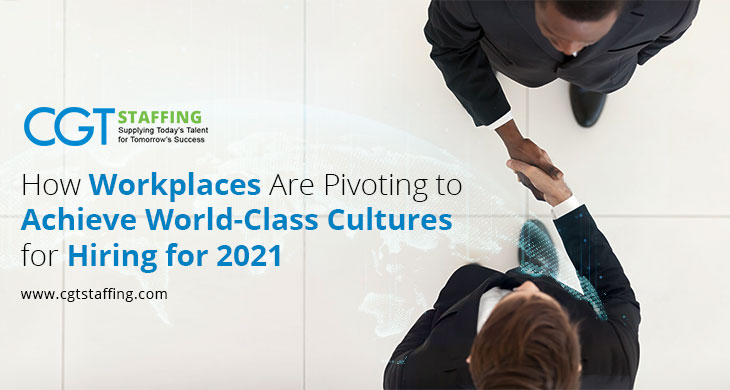Virtually every industry in the U.S. has taken a beating at the hands of COVID-19. The pandemic has ripped through the country, infecting millions of people in a few short months. The strain on the healthcare system and health insurance providers has been intense, not to mention the economic fallout we have witnessed in 2020. Millions of people filed for unemployment in the first few weeks of lockdown.
Week after week of record unemployment claims indicates unemployment on a scale not seen since the Great Depression. Financial pundits warn of a severe recession in the near term. The recent emergence of promising vaccines, however, changes things significantly.
Table of Contents
Probable Workplace Standards in 2021
With large-scale immunization efforts already underway in the US, UK, and Canada, there is a reason to be hopeful. Already, people are beginning to think of a return to life as we knew it before the coronavirus. Barring any unforeseen side effects from the vaccine, this may well come to pass. Individuals aren’t the only people taking the vaccine as a major victory against COVID-19.
Employers all over the country are doing so as well. A successful vaccine could mean the end of Covid-19, the return to some semblance of normal, and most importantly, the resumption of commercial activity.
However, there may be caveats to this. COVID-19 has laid bare the weaknesses in global healthcare, supply chain logistics, workplace safety, and many other areas. It has been a grim lesson in just how unprepared we were for a pandemic-scale health crisis and even less prepared for the ensuing economic impact. A vaccine may neutralize the virus, but its impact will remain for years to come.
However, dynamic businesses can take this as an opportunity to undergo a catalyzed transformation. In other words, businesses have a chance to make strategic changes to workplaces. This includes stakeholders in the hiring function, such as HR managers, mortgage recruiters, and candidates. Understand that this may not be optional anymore.
Nobody wants to be caught unprepared again; to prevent that from happening, employers are trying to evolve beyond the conventional in-office 40-hour workweek. Here are 3 key ways employers are shifting to a smarter and more appropriate work culture in 2021:
Remote Working to Be a Cornerstone of Future Hiring Strategies
Remote work isn’t going away any time soon. Many employers are accepting of this fact and positioning their workplace culture and hiring strategies accordingly. As far as younger workforces go, the idea of a 9-5 workday on-premises was antiquated long before the pandemic began.
COVID-19 offered many businesses the choice between shifting to remote working models or suspending operations indefinitely (in many cases permanently). As a result, more employers today are open to a remote working model as the key to their new workforce strategy in 2021.
Remote working can prove advantageous for several important reasons. The foremost is that it allows employees to conform to the best parts of office culture from the comfort of their homes. At the same time, it removes unnecessary inefficiencies and ineffective bureaucratic exercises.
The result is a modern workforce that can actually work much more efficiently over digital mediums than could be managed in-person. However, to do that, every aspect of your HR policies needs to align with creating a workplace culture that is sustainable and growth-focused. It helps to consult with all stakeholders involved in HR and hiring, including any third-party staffing company and HR personnel.
Reevaluate and Redefine KPIs to Maximize Employee Productivity
The employee experience needs to be redefined to reflect changing workforce strategies in 2021. It’s true that firms now have more talent available to them, but there is still a shortage of many technical skills, which is why employers need to connect more than ever with speciality staffing partners, such as cybersecurity staffing firms.
The shortage of specialty skilled workers has prompted employers to reevaluate the employee value proposition in keeping with the current situation. Given the need to work remotely, businesses need to redesign processes for efficient use. Furthermore, business managers need to brainstorm and redefine KPIs that ensure productivity and efficiency remain as high as possible. Remember, part of your EVP is to offer employees rewards and recognition for achieving key performance milestones. However, with a changing landscape, those milestones need to shift as well.
Rethink Employee Engagement Tactics after Onboarding New Hires
Hiring new workers and driving performance will remain a core focus as businesses gear for growth, or at least recovery, in 2021. However, there is a considerable gap between the initial onboarding and reaching optimal performance. A lot of things can go wrong during this transition, especially in a time when one-on-one physical interactions are not possible.
Employee engagement has always been a core part of workforce retention strategies. The engagement begins with the posting of the advert and job description, but it does not end with the onboarding. Employee engagement continues until the new hire is fully integrated into your workforce.
In 2021, when social distancing and remote working will most likely be in play, you can be sure the need to keep employees engaged will increase. Offering more autonomy, assigning meaningful work, and encouraging two-way feedback is just as workable in a digital setting as it is in person. Keeping employees engaged is a safe way to keep employee turnover at sustainable levels.
